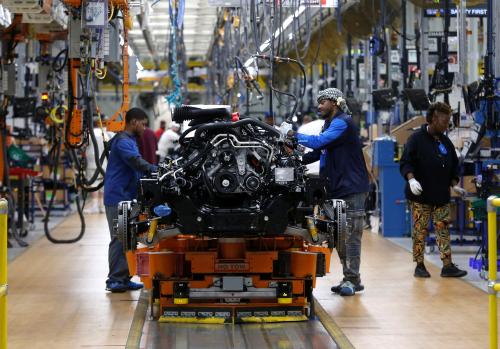Technology seems to be advancing everywhere one looks – in cars, in medicine, in voice recognition, in smartphones, in artificial intelligence. Yet official statistics show that productivity growth (goods and services produced for each hour of work and one gauge of technological progress) has slowed over the past decade. This inconsistency has led some to question whether official measures of Gross Domestic Product (the value of all the goods and services produced in the economy) and productivity are adequately capturing the benefits of innovations.
Karen Dynan of Harvard University and Louise Sheiner of the Brookings Institution discuss these issues, among others, in their paper “GDP as a Measure of Well-being,” published as part of the Hutchins Center on Fiscal and Monetary Policy’s Productivity Measurement Initiative.
To get an idea of how the benefits of technology may be missed in official measures, consider the iPhone, a device which has become indispensable to many of its 90 million U.S. users. Does GDP capture all of the benefits of the iPhone? Should it?
According to Dynan and Sheiner, the benefits of the iPhone should be in GDP—in the sense that properly measured GDP would account for the benefits that consumers derive from their iPhones. In practice, however, these benefits are likely underestimated in official statistics because of the difficulties in measurement. Of course, GDP does take some account of the iPhone: iPhone purchases are counted as consumption, and the wages of the workers in Cupertino and at all the Apple stores across the U.S. are counted as part of income. But two very different sources of mismeasurement suggest that both income and consumption arising from the iPhone are understated. First, the U.S. tax system may provide an incentive for Apple to understate how much of the value of the iPhone stems from work done in the U.S., meaning that domestic profits, and nominal GDP, are understated. Second, comparisons of GDP or productivity from one period to another, require determining how much of an increase in spending is simply price inflation (more money for same thing) and how much is buying more of something, or buying something better. When people spend money on new technologies, the price deflator used to convert that spending into real consumption may not fully reflect the value that consumers get from their purchase, meaning that inflation is overstated. Both of these sources of mismeasurement lead productivity — real GDP per worker — to be understated.
The challenges discussed in this blog are not unique to the iPhone, nor are they new. They reflect the difficulty of accurately measuring GDP in a modern economy, with a large number of multinational companies capable of profit shifting, rapidly changing products, and the frequent entry of new products with no direct comparisons.
Does U.S. GDP appropriately capture Apple’s profits from the iPhone?
Apple is a multinational enterprise with a complex global supply chain, meaning that producers in many different countries contribute to its production. Most of the value of the iPhone derives from its intangible characteristics, like its design and the technological capabilities of its operating system, rather than from its underlying parts — the glass, the computer chip used to run it, etc. This makes it hard for government agencies that put together the GDP statistics to know how much of the value of the iPhone comes from work done in the United States — which is all that counts for the U.S. GDP — and how much is produced abroad. And because the United States taxes domestic profits more heavily than foreign profits, Apple has a big incentive to understate its domestic production. (The recent corporate tax reform changed these incentives somewhat, although it is not clear how much.)
Here’s one method Apple could use to minimize the share of revenue that is taxed in the United States: Apple U.S. contracts with an affiliate in a low-tax country, say Ireland, and leases the rights to its software, blueprints, and branding at a price that is much less than its market value. In other words, Apple Ireland pays Apple U.S. a fee that is less than what Apple would charge if the transaction were arms-length. Apple U.S. is happy to do this because it owns Apple Ireland. Apple Ireland then contracts with manufacturers in other countries, like Foxconn in China, to do the assembly. iPhones are then exported from Ireland to the United States and from Ireland to the rest of the world.
The key here is that the lower the price Apple U.S. charges Apple Ireland, the lower Apple U.S.’s stated profits, the lower the value of the U.S. exports, and the lower measured the U.S. GDP. If the transfer price is artificially low, then so is measured GDP.
Are the benefits that consumers get from the iPhone properly accounted for in GDP?
Even though GDP is often described as a measure of production, Dynan and Sheiner show that it is also, conceptually, a pretty good measure of the benefits that consumers get from the economy. So the benefits from the iPhone — the value that consumers get from it — do belong in GDP. Unfortunately, measuring the value of the benefits from truly novel products is very difficult, perhaps impossible, with current measurement approaches.
When people were first offered the opportunity to buy the iPhone — say, for $500 — their $500 could buy them something that was better than what they could have bought the previous year, before the iPhone had been introduced to the market. The real purchasing power of their money had increased.
Because the value of that $500 had increased, properly measured prices must have declined. What is the source of that price decline? It is the price decline in the iPhone itself. Imagine that consumer demand is such that a small number of people are willing to pay $699 for an iPhone, but no one is willing to pay $700 (what economists call the “reservation price”). When the iPhone is not available for sale, it is as if the iPhone is available, but priced at $700. When the iPhone is introduced at $500, it is as if its price has declined from $700 to $500. If this price decline were in the official price measurements, real GDP would capture the benefits of the iPhone.
But because the $700 is not observed—there is no market for iPhones when no iPhones are sold — official price statistics can’t include it in their official inflation measures. Instead, inflation measures are based only on changes in the prices of actually marketed products. For example, the Bureau of Labor Statistics (BLS) might have used the price changes on older non-smart phones as a proxy for inflation for the whole category of phones, including smart phones. Using this method, the BLS would have missed the price decline coming from the iPhone’s introduction, and inflation would be overstated. Including the implicit price decline would require a very different methodology for truly novel goods, one that uses other kinds of information to figure out consumers’ reservation price.
What about when new iPhone models are introduced? How are those benefits captured?
New iPhone models with more features but higher prices get introduced regularly. Are the benefits of the new models captured? Perhaps.
Up until recently, the method used by the BLS to measure price changes for smartphones was to examine the prices of existing models. So, if the price of the iPhone 6 fell when the iPhone 7 was introduced, then the benefits of that price decline would be captured. But if most people switch to the iPhone 7 even given the decline in the price of the iPhone 6, then that method probably understates the amount of consumer benefit.
Very recently, the BLS has started to explicitly quality-adjust smartphone prices when possible — that is, if the BLS estimated that consumers valued the new iPhone 7 features at $150, they would measure inflation by comparing last year’s iPhone 6 price to this year’s iPhone 7 price less $150. This method can be used when the new features are not that different from existing ones, so that it is possible to estimate their value to consumers. This method doesn’t work so well when new features are truly novel. For instance, if the iPhone 7 is roughly the same phone as the iPhone 6, but with a larger, better screen, and a faster processor, then the BLS can estimate the value of these improvements to consumers. However, if the iPhone 7 has novel features, like the ability to recognize basic human speech or 3D touch, or if the iPhone 7 supports new apps that increase the phones’ functionality, then the contribution of these improvements to consumer welfare is likely missing from GDP.
Properly accounting for the benefits of new technologies would boost the level of GDP, but wouldn’t necessarily eliminate the slowdown in measured growth in output and productivity. That’s because official statistics have always underestimated the benefits of new goods and new technologies. Of course, if productivity growth is increasingly taking the form of new goods and services, rather than lower prices on existing goods and services, the challenges confronting the statistical agencies will only mount over time. To address this, the Hutchins Center at Brookings has embarked on an initiative to improve productivity measurement that is engaging the scholars, government’s statistical agencies, policymakers, and the business community.







Commentary
Productivity measurement in an age of multinational companies and new technologies
November 19, 2018